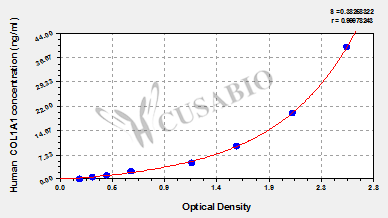Collagen type I alpha 1 (COL1A1) is a structural protein that forms the major component of type I collagen, the most abundant collagen in the human body. This protein provides tensile strength and structural integrity to bone, skin, tendons, and blood vessels. COL1A1 combines with the alpha 2 chain to form the triple helix structure of type I collagen. This makes it necessary for proper extracellular matrix formation and tissue development. Changes in COL1A1 expression link to various pathological conditions, making it an important biomarker in research related to fibrosis, bone disorders, and connective tissue diseases.
The Human collagen, type I, alpha 1 (COL1A1) ELISA kit (CSB-E13445h) measures COL1A1 levels in human samples. This sandwich-based assay works with serum, plasma, cell culture supernates, and tissue homogenates. The detection range spans 0.625 ng/mL to 40 ng/mL with sensitivity of 0.156 ng/mL. The assay requires 50-100 μL sample volume and takes 1-5 hours to complete, with detection at 450 nm wavelength.
Application Examples
Note: The following application examples are drawn from a selection of publications citing this product. For additional applications, please refer to the full list of references in the "Citations" section.
Researchers have used this ELISA kit to study collagen metabolism and tissue remodeling processes. Studies have applied the kit to measure type I collagen levels in cell culture supernatants and tissue samples, particularly in work involving fibroblast biology and extracellular matrix formation.
• Fibroblast research: Measuring type I collagen production in cultured human skin fibroblasts after treatment with bioactive compounds and growth factors
• Tissue regeneration studies: Measuring collagen levels in tissue samples during studies of bone morphogenetic protein signaling and tissue repair mechanisms
• Cell culture applications: Analyzing collagen secretion in human tenocyte cultures during studies of cellular metabolism and glucose uptake processes
• Growth factor research: Measuring collagen production in response to transforming growth factor-beta and other regulatory molecules in controlled cell culture environments






